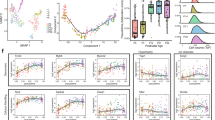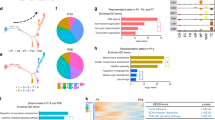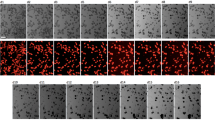Abstract
Nuclear transport of transcription factors is a critical step in stem cell commitment to a tissue-specific lineage. While it is recognized that nuclear pores are gatekeepers of nucleocytoplasmic exchange, it is unknown how the nuclear transport machinery becomes competent to support genetic reprogramming and cell differentiation. Here, we report the dynamics of nuclear transport factor expression and nuclear pore microanatomy during cardiac differentiation of embryonic stem cells. Cardiac progeny derived from pluripotent stem cells displayed a distinct proteomic profile characterized by the emergence of cardiac-specific proteins. This profile correlated with the nuclear translocation of cardiac transcription factors. The nuclear transport genes, including nucleoporins, importins, exportins, transportins, and Ran-related factors, were globally downregulated at the genomic level, streamlining the differentiation program underlying stem cell-derived cardiogenesis. Establishment of the cardiac molecular phenotype was associated with an increased density of nuclear pores spanning the nuclear envelope. At nanoscale resolution, individual nuclear pores exhibited conformational changes resulting in the expansion of the pore diameter and an augmented probability of conduit occupancy. Thus, embryonic stem cells undergo adaptive remodeling of the nuclear transport infrastructure associated with nuclear translocation of cardiac transcription factors and execution of the cardiogenic program, underscoring the plasticity of the nucleocytoplasmic trafficking machinery in accommodating differentiation requirements.
Key Points
-
Embryonic stem cell differentiation into cardiac progeny is associated with remodeling of the nuclear transport machinery
-
Securing the cardiac phenotype from stem cells through nuclear translocation of cardiac transcription factors correlates with acquisition of a distinct proteome
-
Genetic reprogramming by streamlined transcription of nuclear transport genes fingerprints stem cell cardiac commitment
-
Conformational remodeling of the nuclear transport conduit provides the structural substrate for the establishment of the cardiac phenotype
-
Adaptation within the nuclear transport machinery underlies cardiac differentiation and exposes targets to expedite cardiogenesis
This is a preview of subscription content, access via your institution
Access options
Subscribe to this journal
Receive 12 print issues and online access
$209.00 per year
only $17.42 per issue
Buy this article
- Purchase on Springer Link
- Instant access to full article PDF
Prices may be subject to local taxes which are calculated during checkout



Similar content being viewed by others
References
Wente SR (2000) Gatekeepers of the nucleus. Science 288: 1374–1377
Weis K (2003) Regulating access to the genome: nucleocytoplasmic transport throughout the cell cycle. Cell 112: 441–451
Smith AE et al. (2002) Systems analysis of Ran transport. Science 295: 488–491
Dzeja PP et al. (2002) Energetic communication between mitochondria and nucleus directed by catalyzed phosphotransfer. Proc Nat Acad Sci USA 99: 10156–10161
Behfar A et al. (2002) Stem cell differentiation requires a paracrine pathway in the heart. FASEB J 16: 1558–1566
Perez-Terzic C et al. (2003) Structural adaptation of the nuclear pore complex in stem cell-derived cardiomyocytes. Circ Res 92: 444–452
Perez-Terzic C et al. (2001) Directed inhibition of nuclear import in cellular hypertrophy. J Biol Chem 276: 20566–20571
Shevchenko A et al. (1996) Mass spectrometric sequencing of proteins from silver-stained polyacrylamide gels. Anal Chem 68: 850–858
Perkins DN et al. (1999) Probability-based protein identification by searching sequence databases using mass spectrometry data. Electrophoresis 20: 3551–3567
Livak KJ and Schmittgen TD (2001) Analysis of relative gene expression data using real-time quantitative PCR and the 2 - ΔΔ C T method. Methods 25: 402–408
Perez-Terzic C et al. (1999) Structural plasticity of the cardiac nuclear pore complex in response to regulators of nuclear import. Circ Res 84: 1292–1301
Hodgson DM et al. (2004) Stable benefit of embryonic stem cell therapy in myocardial infarction. Am J Physiol Heart Circ Physiol 287: H471–H479
Poon IK and Jans DA (2005) Regulation of nuclear transport: central role in development and transformation? Traffic 6: 173–186
Perez-Terzic C et al. (1996) Conformational states of the nuclear pore complex induced by depletion of nuclear Ca2+ stores. Science 273: 1875–1877
Feldherr CM et al. (1993) Regulation of nuclear transport in proliferating and quiescent cells. Exp Cell Res 205: 179–186
Akey CW (1995) Structural plasticity of the nuclear pore complex. J Mol Biol 248: 273–293
Feldherr C et al. (1998) The nuclear import factor p10 regulates the functional size of the nuclear pore complex during oogenesis. J Cell Sci 111: 1889–1896
Yoneda Y (2000) Nucleocytoplasmic protein traffic and its significance to cell function. Genes Cells 5: 777–787
Hori I and Kishida Y (2003) Quantitative changes in nuclear pores and chromatoid bodies induced by neuropeptides during cell differentiation in the planarian Dugesia japonica. J Submicrosc Cytol Pathol 35: 439–444
Yang Q et al. (1998) Three-dimensional architecture of the isolated yeast nuclear pore complex: functional and evolutionary implications. Mol Cell 1: 223–234
Beck M et al. (2004) Nuclear pore complex structure and dynamics revealed by cryoelectron tomography. Science 306: 1387–1390
Kiseleva E et al. (1998) Active nuclear pore complexes in Chironomus: visualization of transporter configurations related to mRNP export. J Cell Sci 111: 223–236
Mariadason JM et al. (2002) A gene expression profile that defines colon cell maturation in vitro. Cancer Res 62: 4791–4804
Wu X et al. (2001) Disruption of the FG nucleoporin NUP98 causes selective changes in nuclear pore complex stoichiometry and function. Proc Natl Acad Sci USA 98: 3191–3196
Walther TC et al. (2001) The nucleoporin Nup153 is required for nuclear pore basket formation, nuclear pore complex anchoring and import of a subset of nuclear proteins. EMBO J 20: 5703–5714
Guttinger S et al. (2004) Transportin2 functions as importin and mediates nuclear import of HuR. Proc Natl Acad Sci USA 101: 2918–2923
Kasahara H and Izumo S (1999) Identification of the in vivo casein kinase II phosphorylation site within the homeodomain of the cardiac tissue-specifying homeobox gene product Csx/Nkx2.5. Mol Cell Biol 19: 526–536
Borghi S et al. (2001) The nuclear localization domain of the MEF2 family of transcription factors shows member-specific features and mediates the nuclear import of histone deacetylase 4. J Cell Sci 114: 4477–4483
Kaiser FJ et al. (2004) Novel missense mutations in the TRPS1 transcription factor define the nuclear localization signal. Eur J Hum Genet 12: 121–126
Loveland KL et al. (2006) Expression of nuclear transport importins beta 1 and beta 3 is regulated during rodent spermatogenesis. Biol Reprod 74: 67–74
Suzuki T et al. (2006) DNA microarray analysis of changes in gene expression induced by 1,25-dihydroxyvitamin D3 in human promyelocytic leukemia HL-60 cells. Biomed Res 27: 99–109
Tsujita Y et al. (2006) Nuclear targeting of Akt antagonizes aspects of cardiomyocyte hypertrophy. Proc Natl Acad Sci U S A 103: 11946–11951
Beltrami AP et al. (2003) Adult cardiac stem cells are multipotent and support myocardial regeneration. Cell 114: 763–776
Dimmeler S et al. (2005) Unchain my heart: the scientific foundations of cardiac repair. J Clin Invest 115: 572–583
Torella D et al. (2006) Resident human cardiac stem cells: role in cardiac cellular homeostasis and potential for myocardial regeneration. Nat Clin Pract Cardiovasc Med 3: S8–S13
Behfar A and Terzic A (2006) Derivation of a cardiopoietic population from human mesenchymal stem cells yields cardiac progeny. Nat Clin Pract Cardiovasc Med 3: S78–S82
Sanchez PL et al. (2006) Contemplating the bright future of stem cell therapy for cardiovascular disease. Nat Clin Pract Cardiovasc Med 3: S138–S151
Acknowledgements
This work was supported by the National Institutes of Health (NIH), American Heart Association (AHA), Marriott Heart Disease Research Program, Marriott Foundation, Ted Nash Long Life Foundation, Ralph Wilson Medical Research Foundation, Asper Foundation, Heart and Stroke Foundation of Canada, and Mayo Clinic.
Author information
Authors and Affiliations
Corresponding author
Ethics declarations
Competing interests
The authors declare no competing financial interests.
Rights and permissions
About this article
Cite this article
Perez-Terzic, C., Faustino, R., Boorsma, B. et al. Stem cells transform into a cardiac phenotype with remodeling of the nuclear transport machinery. Nat Rev Cardiol 4 (Suppl 1), S68–S76 (2007). https://doi.org/10.1038/ncpcardio0763
Received:
Accepted:
Issue Date:
DOI: https://doi.org/10.1038/ncpcardio0763
This article is cited by
-
Single-cell reconstruction of differentiation trajectory reveals a critical role of ETS1 in human cardiac lineage commitment
BMC Biology (2019)
-
NUP155 insufficiency recalibrates a pluripotent transcriptome with network remodeling of a cardiogenic signaling module
BMC Systems Biology (2018)
-
Nuclear envelope structural proteins facilitate nuclear shape changes accompanying embryonic differentiation and fidelity of gene expression
BMC Cell Biology (2017)
-
Expression and subcellular distribution of imp13 are regulated in brain development
In Vitro Cellular & Developmental Biology - Animal (2013)
-
Nuclear Reprogramming with c-Myc Potentiates Glycolytic Capacity of Derived Induced Pluripotent Stem Cells
Journal of Cardiovascular Translational Research (2013)



